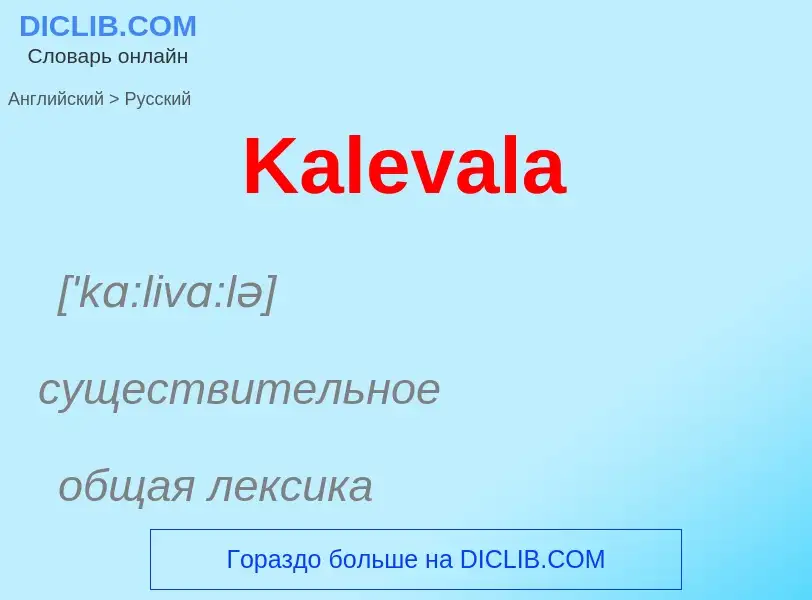Vertaling en analyse van woorden door kunstmatige intelligentie ChatGPT
Op deze pagina kunt u een gedetailleerde analyse krijgen van een woord of zin, geproduceerd met behulp van de beste kunstmatige intelligentietechnologie tot nu toe:
- hoe het woord wordt gebruikt
- gebruiksfrequentie
- het wordt vaker gebruikt in mondelinge of schriftelijke toespraken
- opties voor woordvertaling
- Gebruiksvoorbeelden (meerdere zinnen met vertaling)
- etymologie
Kalevala - vertaling naar russisch
['kɑ:livɑ:lə]
существительное
общая лексика
«Калевала» (карело-финский эпос)
Wikipedia

The Kalevala (Finnish: Kalevala, IPA: [ˈkɑleʋɑlɑ]) is a 19th-century work of epic poetry compiled by Elias Lönnrot from Karelian and Finnish oral folklore and mythology, telling an epic story about the Creation of the Earth, describing the controversies and retaliatory voyages between the peoples of the land of Kalevala called Väinölä and the land of Pohjola and their various protagonists and antagonists, as well as the construction and robbery of the epic mythical wealth-making machine Sampo.
The Kalevala is regarded as the national epic of Karelia and Finland and is one of the most significant works of Finnish literature with J. L. Runeberg's The Tales of Ensign Stål and Aleksis Kivi's The Seven Brothers. The Kalevala was instrumental in the development of the Finnish national identity and the intensification of Finland's language strife that ultimately led to Finland's independence from Russia in 1917. The work is also well known internationally and has partly influenced, for example, J. R. R. Tolkien's legendarium (i.e. Middle-earth mythology).
The first version of the Kalevala, called the Old Kalevala, was published in 1835, consisting of 12,078 verses. The version most commonly known today was first published in 1849 and consists of 22,795 verses, divided into fifty folk stories (Finnish: runot). An abridged version, containing all fifty poems but just 9732 verses, was published in 1862. In connection with the Kalevala, there is another much more lyrical collection of poems, also compiled by Lönnrot, called Kanteletar from 1840, which is mostly seen as a "sister collection" of the Kalevala.


![The tragedy of [[Kullervo]] has been a source of inspiration for several artists. <small>(''Kullervo's Curse'', Gallen-Kallela, 1899)</small> The tragedy of [[Kullervo]] has been a source of inspiration for several artists. <small>(''Kullervo's Curse'', Gallen-Kallela, 1899)</small>](https://commons.wikimedia.org/wiki/Special:FilePath/Akseli Gallen-Kallela - Kullervo Cursing - Google Art Project.jpg?width=200)

![''Kullervo Speaks to His Sword'' by [[Carl Eneas Sjöstrand]], 1868 <small>(cast into bronze in 1932)</small> ''Kullervo Speaks to His Sword'' by [[Carl Eneas Sjöstrand]], 1868 <small>(cast into bronze in 1932)</small>](https://commons.wikimedia.org/wiki/Special:FilePath/Kullervo puhuu miekalleen.jpg?width=200)
![Entrance hall of the [[National Museum of Finland]] with Kalevala frescoes by Gallen-Kallela Entrance hall of the [[National Museum of Finland]] with Kalevala frescoes by Gallen-Kallela](https://commons.wikimedia.org/wiki/Special:FilePath/Le hall du musée national de Finlande (Helsinki).jpg?width=200)
![''Ilmatar'' by [[Robert Wilhelm Ekman]], 1860 ''Ilmatar'' by [[Robert Wilhelm Ekman]], 1860](https://commons.wikimedia.org/wiki/Special:FilePath/Robert Wilhelm Ekman - Ilmatar - A II 1256 - Finnish National Gallery.jpg?width=200)
![Väinämöinen is deeply identified with his [[kantele]]. <small>(''Väinämöinen's Play'', Robert Wilhelm Ekman, 1866)</small> Väinämöinen is deeply identified with his [[kantele]]. <small>(''Väinämöinen's Play'', Robert Wilhelm Ekman, 1866)</small>](https://commons.wikimedia.org/wiki/Special:FilePath/Robert Wilhelm Ekman - Väinämöinen’s Play.jpg?width=200)
![Mistress of the North, Louhi attacking Väinämöinen in the form of a giant eagle with her troops on her back. <small>(''[[The Defense of the Sampo]]'', Akseli Gallen-Kallela, 1896)</small> Mistress of the North, Louhi attacking Väinämöinen in the form of a giant eagle with her troops on her back. <small>(''[[The Defense of the Sampo]]'', Akseli Gallen-Kallela, 1896)</small>](https://commons.wikimedia.org/wiki/Special:FilePath/Sammon puolustus.jpg?width=200)
